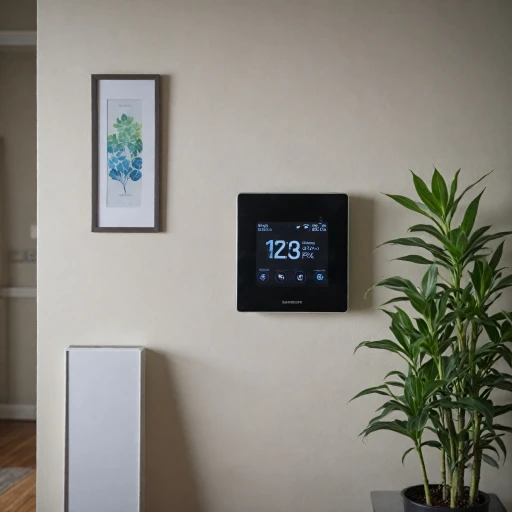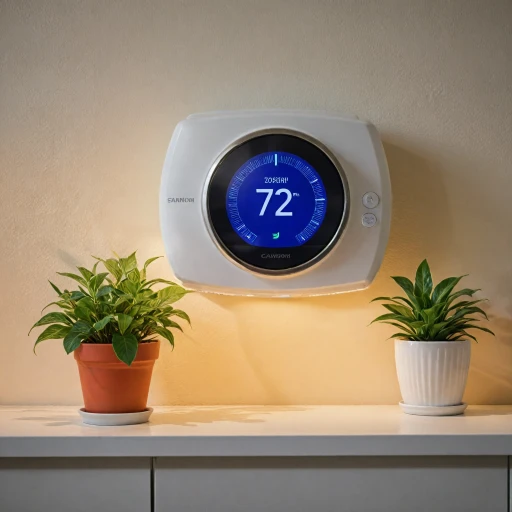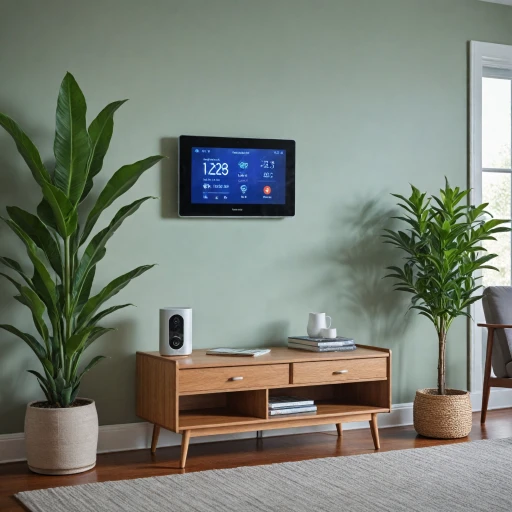What is a Baseboard Thermostat?
Introduction to Baseboard Thermostats
Baseboard thermostats are a key component in managing the heat output of your electric baseboard heaters. These heaters are a popular choice in many homes due to their efficiency and ability to heat spaces evenly. Baseboard thermostats help control the temperature by regulating the flow of electricity to the heaters, ensuring your rooms maintain the desired warmth. When it comes to integrating a smart thermostat system, it's important to understand the basics of how these thermostats operate in conjunction with your existing heating system.
Typically, baseboard thermostats are either single pole or double pole. A single pole thermostat provides a basic on-off control, while a double pole thermostat can completely disconnect power, offering enhanced safety. Understanding the difference between these types is crucial when deciding which thermostat to buy for your home.
Modern smart thermostats, like those from Mysa or Honeywell, have added smart features that enhance their functionality. These thermostats can be programmable, allowing you to schedule when your heating operates, or even connect to your smartphone through Android or iOS applications, providing remote access and monitoring. Such smart thermostats help in energy usage optimization, which can significantly impact your heating bills.
For homes with electric heating systems, like fan forced or high voltage heaters, ensuring compatibility with selected thermostats is essential. It's worth noting that installation may require specific wiring configurations or even circuit breaker adjustments. You might find comparisons helpful when choosing the best model for your requirements.
Curious about integrating smart features with a Z Wave hub? This can provide additional benefits and flexibility discovering the potential of a Z Wave hub can offer significant advantages for your smart thermostat setup.
Energy Efficiency and Cost Savings
Maximizing Efficiency and Reducing Costs with a Modern Approach
Understanding how a baseboard thermostat can contribute to energy efficiency and cost savings is crucial for any homeowner looking to optimize their heating system. Modern baseboard heaters, often electric, benefit greatly from advanced thermostats, such as programmable and smart models, to manage energy usage more effectively. Using a programmable thermostat can dramatically reduce unnecessary heating. By setting your Mysa smart thermostat or other programmable options to lower the temperature when you're not home or during sleeping hours, you can significantly cut your energy bills. This not only optimizes efficiency but also contributes to reducing your household's environmental footprint. Moreover, baseboard heaters with advanced thermostats can adjust the heating based on your daily routine. Whether you have a single pole or double pole thermostat, features like vacation mode and the ability to program specific heating schedules tailored to your lifestyle can save on costs and enhance convenience. For homes dealing with high voltage systems, the right programmable thermostat plays a vital role. A Honeywell model, for instance, often accommodates fan forced or electric baseboard heaters, effectively managing the power and ensuring durability of the heating components through optimal energy usage. By selecting the appropriate thermostat, you’ll be managing the heat distribution efficiently. Lastly, while examining the range of available products, consider the compatibility with android and ios devices. This integration allows you to control your heating system remotely, providing real-time adjustments and ensuring you’re never heating an empty home again. For those keen on delving deeper into the advantages of optimized heating systems, you might find additional insights in this comprehensive discussion on heating practices with a two-stage thermostat.Smart Features of Modern Baseboard Thermostats
Advanced Functionalities of Contemporary Thermostats
Today's thermostats have evolved significantly, adding layers of convenience and efficiency to electric baseboard heating systems. Among these advancements, smart thermostats like the Mysa smart thermostat stand out for their modern features and adaptability. But what exactly makes these smart thermostats a worthy addition to your home?
For starters, these smart thermostats are designed to be programmable, allowing you to set daily or weekly heating schedules that align with your lifestyle. This feature not only helps in optimizing energy usage by ensuring heat is provided only when needed, but it also contributes to cost savings in the long run. Beyond simple programmability, these devices often come equipped with vacation mode settings, which can be a boon for homeowners looking to minimize energy consumption while away.
Connectivity is another hallmark of smart thermostats. Many models offer seamless integration with both Android and iOS devices, providing remote control capabilities through dedicated apps. This means that whether you're on the go or simply lounging at home, you have the power to adjust your baseboard heaters' settings at your fingertips.
Additionally, some smart thermostats are designed to support both single pole and double pole configurations, which can be a crucial consideration when dealing with high voltage electric baseboard heaters. This compatibility ensures that whether you're installing in a new home or retrofitting an existing heating system, these smart solutions can be easily integrated.
Lastly, many of these devices come with energy monitoring features, giving you insights into your heating system’s performance and energy use trends. With this data, homeowners can make informed decisions to further optimize their heating and reduce overall energy expenditure.
In conclusion, the smart features offered by modern baseboard thermostats cater to a wide array of needs, from ease of use to significant energy efficiency gains. These enhancements make them a compelling choice for anyone looking to upgrade their home heating solutions. For more on this topic, check out our detailed guide on line voltage thermostats and their impact on energy management.
Installation and Compatibility Considerations
Setting Up Your Baseboard Thermostat: Steps and Considerations
When considering the installation of a baseboard thermostat, understanding the compatibility with your existing heating system is crucial. Baseboard heaters typically operate on high voltage, whether single pole or double pole thermostats are selected. Notably, ensuring compatibility with a 240-volt thermostat or a lower 120-volt thermostat is vital since mixing these could lead to inefficiencies or even hazards. Before installation, verify the power requirements. Baseboard heaters, recognized for their electric nature, require specific wiring arrangements. Some installations might require connecting the thermostat into the circuit breaker, necessitating a careful review of the wires involved. Employing a licensed electrician might be a prudent choice if you're unfamiliar with electric installations. Single pole thermostats might work for your needs, but double pole thermostats offer an extra level of control, especially useful if you plan to use them with programmable thermostats like the Honeywell or Mysa smart systems. Programmable thermostats make an excellent add-on, providing flexibility in managing your heating and cooling schedules. They save energy by adapting to your daily routines, but their installation can vary in complexity. Look for models that offer clear, user-friendly instructions compatible with Android and iOS devices for seamless smart control. Consideration should be given to the programmable features that align with your lifestyle, such as a vacation mode that reduces energy usage while you're away. Common smart thermostats, like Mysa smart devices, integrate well with electric baseboards, offering long-term cost savings through improved energy efficiency. In summary, while setting up a baseboard thermostat involves a few steps, it can be greatly rewarding. Correct installation improves the lifespan of your system, optimizes energy usage, and enhances home comfort. When choosing a thermostat, add options to your cart that meet your heating requirements and are compatible with your voltage and wire specifications.Troubleshooting Common Issues
Troubleshooting Challenges with Baseboard Thermostats
Dealing with thermostat issues can be frustrating, especially when your electric baseboard heater isn’t providing the desired warmth. Here's a quick guide to help navigate some common problems that may arise with baseboard thermostats:- Lack of Power to the Thermostat: If your programmable thermostat or the more advanced Mysa smart thermostat isn’t powering on, check the circuit breaker to ensure it hasn't tripped. Also, verify that the wiring is intact and securely connected.
- Inaccurate Temperature Readings: A thermostat that displays inaccurate temperatures can affect heating efficiency. Ensure that the thermostat is properly mounted away from drafts or direct sunlight, as these factors can skew temperature readings.
- Baseboard Heater Not Heating: If your baseboard heater doesn't generate heat, verify that the unit receives adequate power. Inspect the wires and connections for signs of wear or burn marks, which may indicate a need for repair or replacement.
- Compatibility Issues: Ensure compatibility between your thermostat (like Honeywell or others) and the baseboard system, especially when dealing with single pole or double pole wiring configurations. Double pole thermostats require a higher voltage, so understanding the type of pole thermostat your system uses can prevent headaches.
- Programming Difficulties: If you experience challenges programming your thermostat, consult the manual for specific instructions on setting heat schedules. For more advanced baseboard programmable thermostats, familiarize yourself with any app-based features available on Android or iOS platforms.
Choosing the Right Baseboard Thermostat for Your Home
Evaluating Your Home's Heating Requirements
Choosing the right baseboard thermostat requires understanding your home’s specific heating requirements. Consider the size and layout of your space, as well as the type of baseboard heaters you have installed. Electrical baseboards vary in terms of voltage, and ensuring compatibility with your current heating system is crucial.
Compatibility with Existing Wiring
The type of wiring in your home will also influence your choice. Whether your home uses a single pole or double pole thermostat, it's important to select a device that accommodates the present wiring setup, including circuits, to ensure seamless integration and performance.
Choosing Between Programmable and Smart Options
When selecting a baseboard thermostat, decide between programmable or smart thermostats. A programmable thermostat allows for scheduled heating, helping maximize energy usage efficiency. On the other hand, smart thermostats like the Mysa smart baseboard thermostats offer advanced features such as remote control via Android or iOS apps, vacation mode for energy savings, and integration with smart home ecosystems.
Brand and Model Considerations
Brands like Honeywell, Mysa, and others provide reliable options. When searching for thermostats, consider the brand's reputation, customer reviews, and the specific features they offer. Some models offer unique benefits such as high voltage support or fan forced heating capabilities, so assess what aligns with your household needs.
Installation and Technical Support
Before adding a thermostat to your cart, ensure that the installation process matches your skills. Some models require professional installation, especially if dealing with high voltage and complex wiring systems. Check if the brand offers guidance or support for troubleshooting during installation.
Future-Proofing Your Investment
Choose a model that not only fits current needs but is also adaptable for future upgrades. A future-proof climate control device should ideally support software updates and integrate with evolving smart home technologies. Understanding these factors can help you find a baseboard heater solution that enhances comfort and efficiency in your home.









